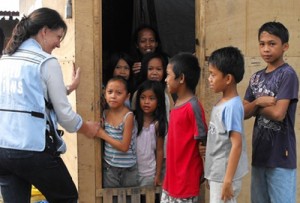(One month on from Typhoon Yolanda (known internationally as Haiyan), the UN Resident and Humanitarian Coordinator for the Philippines, Luiza Carvalho, looks back on the challenges and achievements of the international aid community, which is working closely with the Filipino authorities to respond to the disaster.)
It is hard to believe that it has been one month since Super Typhoon Yolanda made landfall. In many ways, it feels like it has only been a matter of days. For the humanitarian community involved in the response, the past month has been focused on the huge task of establishing, expanding and coordinating a massive international humanitarian effort to support the lead taken by the Philippine government.
Looking back, this past month can be split into two distinct phases. The first phase occurred in the first week of the response when we focused on overcoming logistical challenges to ensure that our aid operation was up and running, despite the obstruction of roads and destruction of public infrastructure.
Countless hours were spent in the field and in Manila trying to maneuver our way through a litany of issues: establishing aid pipelines through Tacloban’s battered airport and into its damaged port; trying to secure enough vehicles to carry aid and personnel from these entry points to the communities in need of assistance; securing fuel to run those vehicles; gathering sufficient information across the affected areas to prioritize and coordinate the response. Assessing the damage, planning relief operations and delivering aid were all done simultaneously.
The second phase started just over a week after the storm. This was when momentum began to build. The amount of specialized teams and aid entering the affected area increased dramatically. It is worth highlighting a few facts and figures to make this point: a huge international health response is underway with more than 180 health teams deployed to the affected zone and a major vaccination campaign is being rolled out for children under five. Humanitarian partners have supported the government to provide food to over 4 million people affected by the storm. More than 20,000 families have been provided with rice seeds in time for planting.
Humanitarian agencies have delivered shelter materials and non-food-items to tens of thousands of families whose homes were badly damaged or destroyed. We are helping children return to school and we are providing support to the most vulnerable groups, such as specialized medical care for thousands of pregnant women. To help families recover and rebuild communities, UN agencies and international NGOs are implementing cash-for-work and other livelihood programmes.
Despite all the trauma and distress they have been through, the survivors of this typhoon are demonstrating remarkable resilience. Communities are bouncing back and debris is being cleared so that the rebuilding can begin. Goods are returning and markets and economic activity is picking up. Building resilience by emphasizing disaster risk reduction measures has been at the centre of the government’s relief and recovery efforts.
None of these achievements would have been possible without the impressive work of the government agencies under the leadership of President Aquino and his cabinet. I have seen government authorities and their staff working round the clock to provide relief to people in need. It is important to also recognise the critical role of our international partners in bringing the relief operation to scale. At all times, the humanitarian response has been and will continue to be underpinned by the humanitarian principles of humanity, neutrality and impartiality to ensure we serve the most vulnerable.
The reports from these joint efforts are encouraging – our mutual trust, respect and the values we share are helping us advance faster.
We now have a more solid understanding of the magnitude of the needs and are moving rapidly to a new phase, characterized by a sense of momentum and confidence, not only of humanitarian workers but also of the people we serve. The focus of the third phase is to ensure that the humanitarian situation will improve and that our recovery efforts continue to gain momentum and dovetail with the Government’s Yolanda Recovery and Reconstruction Plan. This entails supporting a return to full economic activity, with reconstitution of critical social services that will enable people to enjoy productive and sustainable livelihoods.
Typhoon Yolanda was the most powerful storm to ever make landfall, but it was not the first and it is not likely to be the last act of nature that the Philippines will face. In partnership with the Government, our job in the coming months and years will be to ensure that when future shocks hit, people can reach safety and return to their lives in a matter of weeks, not months or years.
I have travelled throughout the affected zone a number of times now. I have seen first-hand the utter devastation of cities and towns that took direct hits from Yolanda. I have seen the raw grief of mothers and fathers who have lost their children, and the bewilderment of people who now face a long and difficult recovery.
I have also seen how efficient international support can be when it comes together in close partnership with local communities and under the leadership of the government. But I also know that our greatest asset in this fight to rebuild and to rebuild better is the people of the Philippines. I have been struck yet again by the strength, kindness and resilience of the Filipino people. Any effective response should be fuelled by courage and determination. The people of the Philippines possess both. They are this country’s greatest resource.


